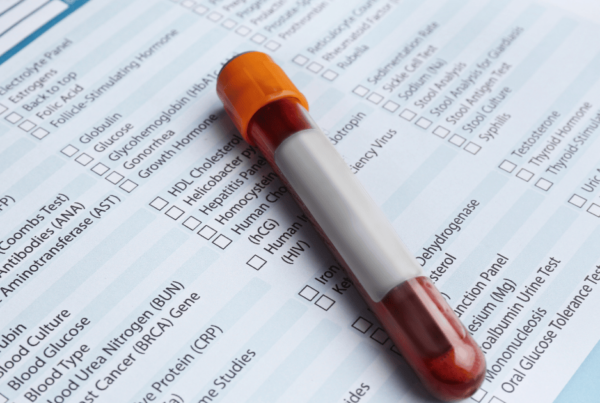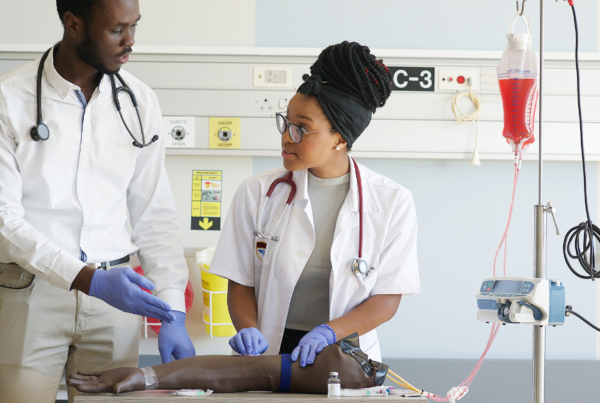Routine venipuncture is a fundamental skill in the field of phlebotomy, essential for collecting blood samples for diagnostic testing. Mastering this procedure is crucial for phlebotomists to ensure patient safety, comfort, and the accuracy of results. In this guide, we’ll cover the entire venipuncture process, highlighting important safety protocols, patient care, and potential complications. This comprehensive overview will be particularly useful for students, new professionals, and those refining their skills.
| Key Takeaways |
| Routine venipuncture is a fundamental phlebotomy procedure used to collect blood samples for diagnostic testing. |
| Always follow proper patient identification and informed consent protocols before proceeding with the venipuncture. |
| The most common venipuncture site is the median cubital vein, though other veins may be used when necessary. |
| Avoid drawing from restricted areas (legs, feet) or compromised limbs (mastectomy or stroke-affected side) without approval from a physician. |
| Maintain patient safety by following the correct order of blood draw, proper cleaning, and ensuring hemostasis after the procedure. |
| Proper labeling and disposal of materials are essential for sample accuracy and safety compliance. |
| Patient comfort and clear communication are key to providing a positive experience during venipuncture. |
What is Routine Venipuncture?
Routine venipuncture is the process of drawing blood from a vein, typically for laboratory testing. The procedure is straightforward but requires precision and knowledge of anatomy, technique, and safety protocols. Venipuncture is most commonly performed on the median cubital vein in the antecubital fossa (the inner elbow), but other veins, such as those in the hands, can be utilized as well.
Venipuncture is a skill that relies on both technical proficiency and patient-centered care, making it important to handle each procedure with care and attention to detail. By mastering the steps of routine venipuncture, you’ll minimize the risk of complications such as bruising, infection, or patient discomfort.
Key Precautions Before Performing Routine Venipuncture
1. Avoid Restricted Areas
Certain areas should not be used for routine venipuncture without proper approval, such as the legs and feet. These areas are more prone to complications, including infection and clotting, especially in patients with diabetes, cardiovascular issues, or coagulation disorders. Only RNs or specially trained personnel should perform venipuncture in these areas, and proper documentation of training is required.
2. Special Cases: Mastectomy, Stroke, and IV Sites
Phlebotomists must exercise caution when drawing blood from patients with a history of mastectomy or stroke. Never apply a tourniquet to the arm on the same side as a mastectomy or stroke, as this could lead to complications such as lymphedema. If the patient has an IV drip in one arm, it’s preferable to draw blood from the opposite arm. However, if that’s not possible, blood may be drawn below the IV site as long as the IV has been turned off for at least one hour.
Always note the site of the draw on the requisition form to ensure that laboratory staff is aware of any special conditions.
3. Arterial Blood Draws and Scope of Practice
It’s important to note that arterial blood draws for routine testing should only be performed by licensed medical providers in a clinical setting. This procedure is outside the scope of practice for phlebotomists, and attempting it without proper training can lead to severe complications such as nerve damage, thrombosis, or hemorrhage. Phlebotomists should focus on routine venipuncture and leave arterial punctures to licensed professionals.
Patient Identification and Consent
Before performing routine venipuncture, ensure that the patient is correctly identified. Ask the patient to state their name and compare it with the requisition form. Visual recognition alone is not enough and should only be used as a secondary identifier. Accurate identification ensures that the right tests are performed on the right person.
Next, inform the patient of the procedure and answer any questions they may have. Informed consent is critical. If a patient refuses the procedure, their decision must be respected, and they cannot be coerced into compliance. In such cases, document the refusal on the requisition form and notify the attending physician or nurse. Phlebotomists should be aware that obtaining blood without consent could result in legal consequences.
For pediatric patients, gaining cooperation may require extra care. If a child refuses, ask the parents to leave the room if necessary, or request a physician to speak with the child. Consent must still be obtained even if parents insist on the procedure.
Step-by-Step Process for Routine Venipuncture
1. Verify Any Diet or Medication Restrictions
Some blood tests require patients to follow specific dietary restrictions or to take their medication at a particular time. Always verify whether the patient is fasting or has adhered to medication instructions before proceeding with the venipuncture.
2. Prepare the Venipuncture Equipment
Before beginning, ensure that you have all the necessary equipment, including:
- Tourniquet
- Alcohol swabs
- Gloves
- Appropriate collection tubes
- Needle (typically a 21-23 gauge)
- Sharps container
- Gauze and bandages
Have everything ready before applying the tourniquet to avoid delays, which can cause unnecessary discomfort for the patient.
3. Select the Venipuncture Site
The most common site for routine venipuncture is the median cubital vein within the antecubital fossa. If veins in the arm are inaccessible, the dorsal venous arch in the hand can serve as an alternative site. Avoid drawing blood through moles, scars, or areas with skin irregularities.
4. Apply the Tourniquet and Palpate the Vein
Apply the tourniquet around 3-4 inches above the intended puncture site, ensuring that it’s tight enough to make the veins prominent without cutting off circulation. The tourniquet should not be left on for more than two minutes, as this can lead to hemoconcentration, which could alter the results of the blood tests.
5. Clean the Puncture Site
The puncture site can be cleaned using an alcohol swab. Allow it to air dry completely—do not blow on the area or fan it, as this can introduce contaminants. For specific tests such as blood cultures or blood alcohol levels, follow the required cleansing protocols.
6. Insert the Needle
Once the area is dry, insert the needle into the vein at a 15-30 degree angle. Securely attach the evacuated tube to the needle holder, allowing it to fill according to the proper draw order protocol. Draw only the necessary amount of blood to avoid overfilling tubes or causing patient discomfort.
7. Release the Tourniquet and Remove the Needle
After the collection tubes have been filled, release the tourniquet before removing the needle. This helps prevent unnecessary pressure on the vein, reducing the risk of hematoma formation.
8. Apply Pressure and Ensure Hemostasis
Immediately after removing the needle, apply gentle pressure with gauze to the puncture site. Ask the patient to maintain pressure for 3-5 minutes, keeping their arm straight. If bleeding continues, raise the patient’s arm and advise them to maintain pressure.
Patients on anticoagulants like Coumadin may take longer to clot, so monitor them closely before bandaging the area.
9. Label the Samples
Label the blood collection tubes with the patient’s full name, patient number, time, date, and your initials. Proper labeling is crucial for ensuring that the right samples are processed with the correct information.
10. Dispose of Waste Properly
Engage the needle’s safety device and dispose of it in the designated sharps container. Make sure all equipment used during the procedure is properly discarded or stored.
Post-Procedure Patient Care
After completing the venipuncture, ensure that the patient feels comfortable and monitor the puncture site for any signs of bleeding or bruising. Offer aftercare instructions, including keeping the bandage in place for at least 15 minutes and avoiding heavy lifting with the affected arm.
Finally, thank the patient and ask if they have any additional questions or concerns.
FAQs on Routine Venipuncture
What is the best vein for routine venipuncture?
The median cubital vein in the antecubital fossa (inner elbow) is the preferred site for routine venipuncture due to its accessibility and size. However, the dorsal venous arch in the hand can also be used when necessary.
Can phlebotomists perform arterial blood draws?
No, phlebotomists are not licensed to perform arterial blood draws. Arterial punctures must be conducted by licensed medical providers in a clinical setting.
Why can’t a tourniquet be applied to the same side as a mastectomy?
Applying a tourniquet to the same side as a mastectomy can lead to complications like lymphedema, swelling, and circulation issues, so it should be avoided.
What should I do if a patient refuses venipuncture?
If a patient refuses, respect their decision. Document the refusal on the requisition form and notify the attending physician or nurse. Never force or coerce a patient into the procedure.
How long should pressure be applied to the venipuncture site after drawing blood?
Apply pressure to the site for 3-5 minutes. If the patient is on anticoagulants like Coumadin, they may require more time to stop bleeding.
Can I draw blood from a patient with an IV in place?
If possible, draw from the opposite arm. If this is not possible, blood can be collected from below the IV site, but the IV must be turned off for at least one hour prior to the venipuncture.
Why is it critical to follow the order of draw?
Following the correct order of draw prevents contamination between tubes, ensuring that the test results are accurate and reliable.
How long should a tourniquet be left on the patient?
A tourniquet should not remain on the patient for longer than two minutes, as this can lead to hemoconcentration and impact test results.
What happens if venipuncture is performed improperly?
Improper venipuncture can result in complications such as hematoma (bruising), thrombosis (blood clots), infection, and nerve damage. Following the correct procedure minimizes these risks.
How should I clean the venipuncture site?
Clean the site with an alcohol swab, and allow it to air dry completely. For specific tests like blood cultures, follow the recommended cleaning protocol.
Conclusion
Mastering routine venipuncture is a critical step in the journey to becoming a proficient phlebotomist. By following the proper steps, from patient identification and consent to the final labeling of blood samples, you can ensure safe and efficient procedures. Routine venipuncture is not only a technical task but also an opportunity to demonstrate empathy and professionalism toward patients. With practice and attention to detail, aspiring phlebotomists can build their confidence and competence in this essential procedure.
Ready to master the art of venipuncture?
Whether you’re a student or a new professional, perfecting this skill is key to becoming a successful phlebotomist. At Phlebotomy Now, we offer comprehensive courses that guide you through every step of the process.
Enroll today and gain the knowledge and hands-on experience you need to excel in your career.


